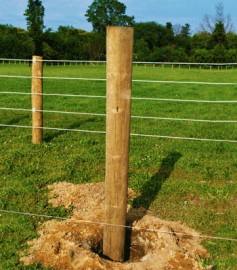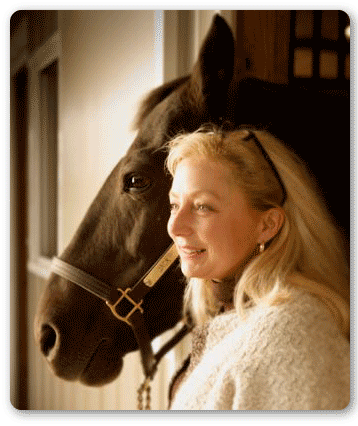Posts: The Backbone of Your Fence System

The posts hold the whole system together, keeping the rails in place, offering stability between rails and supporting braces throughout the entire run of fence. ''Just like a backbone,'' I thought. And just like we couldn't function properly without a strong backbone, a fence cannot do its job without proper posting and bracing.
But, posts are often taken for granted when planning a fence, simply because every fence needs posts. It's important to remember that your posts are the support of your fence and need to last as long as your rails. Like most things in life, when it comes to fence post, you get what your pay for. A good deal may not be what you think it is. Watch for the following ''good deals'' that could mean bad news down the road.
What different types of posts can you get for your horse fencing system?
If you are looking at posts that are cheaper than everything else, check for wood types such as oak or locust. These woods are moderately easy to work with after milling, but become extremely hard within a year. Most nails or screws used with these posts will require you drill a pilot hole in order to allow installation. Though harder woods can be a benefit in the right circumstance, the wood can break and splinter when it is hit, creating a hazard to your horse. Red pine posts are most commonly used in fencing because they are easy to nail, strong and affordable. Southern yellow pine proves to be stronger than red, but comes with a price tag to match the quality. Landscape timbers are naturally treated because they come from the middle or core of the tree. However, just looking at their name tells us where they should be used. They are not the best choice for horses and long wearing life. If at all possible, avoid using them. They deteriorate much faster and are not long enough to get the length you need both in and above the ground.
What do retention levels mean when when talking about horse fencing posts?
Most treated posts carry a retention level that indicates the life of the post. A ''.40 retention'' level indicates a 40-year life expectancy (use .60 if you are putting concrete around a post). The key to a good post is not only the retention level, but also how far the treatment penetrates into the post. Kiln-dried posts cost a bit more, but the treatment is absorbed deeper into the post. Look for tagged posts with warranties included. Most post warranties cover underground deterioration according to the retention level. Anything that damages the post above ground, including a horse kick or equipment accident, is not covered. Because such damage would not be covered in the warranty, it is very important for horse owners to choose the best quality post that is within their budget. It's also a good idea to think about supplementing your fence system with electric fence. This not only keeps your horse safer, but also protects your investment in the fence.
For your horse fencing system, should you get round, square or faced posts?
It is important to consider the rail you have chosen when selecting the shape of your post. Round posts have become the most popular choice for many horse owners. A round post can withstand a great deal of pressure and force, and has less surface space when hit. The round post allows ''sliding off'' of the surface, which is a safer alternative to a flat surface. Square posts have been popular for years with board fence. But I must emphasize, square posts have more surface space and a 90-degree corner that can catch on a horses' shoulder. ?Half-rounds or faced posts can be an attractive alternative, but you get only half the strength when it is hit or rubbed on. Having used all of these posts, my first choice is a pressure treated round post.
Beware of skimping on your post length to save money on your horse fencing system.
The most important thing to remember in selecting your post is the length. Skimping on post length to save money only costs you later. Line posts should be 3 ft. under ground in cold winter climates and 2 - 2 1/2 ft. in warm winter climates. Brace posts that are larger in diameter and longer (9 ft. and longer) should be purchased per manufacturer's instructions. Also, be sure to follow bracing specifications, footers, concrete amounts and other suggested bracing methods. The manufacturer's supply them to help you have the longest lasting system possible.
Straight lines are crucial to any horse fencing system!
Use a string line to mark all areas. Spray paint post spacing on the ground following your string line. Crooked lines weaken your whole fence system. Rails can pull on brackets or boards and will pull out easier, creating a very unsafe home for your horse.
There is a lot to be said about your posts. They hold your rail in place and keep your horses in. Closer post spacing is a better choice with horses. You will have tighter stability between the rails and a stronger system. Preplanning costs during your farm project should include the most important part of your horse's home, his pasture. For further information on posts prices or to discuss your questions about posts, please email me.
Special thanks to Dave Walton for updated facts.
 Debbie has over 45 years experience with horses and equine-related businesses. She has owned, trained, boarded horses and run stables at various times in her career. She is a certified fence installer, has given balanced riding lessons, and has shown horses in Western, Western Pleasure, Trail, English, Hunter/Jumper, Fox Hunting, Hunter Trials, Dressage and driving classes. Debbie has been involved in foaling, and just about every aspect of horse ownership possible, and she welcomes your questions and comments. If you are interested in using any articles by Debbie, please send her an email.
Debbie has over 45 years experience with horses and equine-related businesses. She has owned, trained, boarded horses and run stables at various times in her career. She is a certified fence installer, has given balanced riding lessons, and has shown horses in Western, Western Pleasure, Trail, English, Hunter/Jumper, Fox Hunting, Hunter Trials, Dressage and driving classes. Debbie has been involved in foaling, and just about every aspect of horse ownership possible, and she welcomes your questions and comments. If you are interested in using any articles by Debbie, please send her an email.
RAMM Fence Systems, Inc. makes every effort to provide reliable and useful information on horse health, care and products. The statements made on this website are based on years of experience with horses, however, they are based on generalized situations and should not replace diagnosis or treatment by a veterinarian or consultation by a professional. RAMM Fence Systems, Inc. does not assume any legal responsibility. Readers should always consult qualified health care providers for specific diagnosis and treatment.
